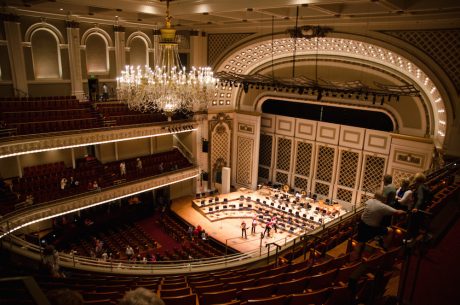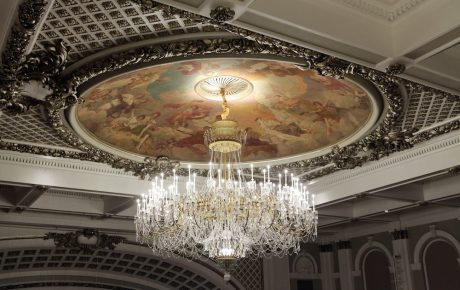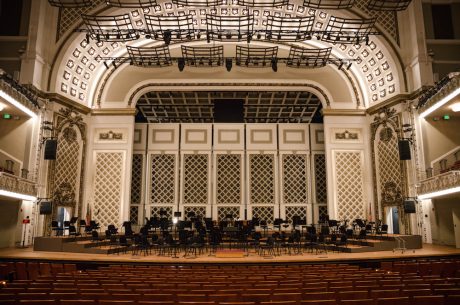
MIDDLETON, WI– Built in 1878, Cincinnati Music Hall has long housed performances by the Cincinnati Ballet, Symphony Orchestra, Opera and more. Its ornate architectural features earned the building its status as a National Historic Landmark by the U.S. Department of the Interior. Nearing 40 years since its most recent renovation, the venue needed a major remodeling to improve its infrastructure and audience experience. To execute the revitalization of Cincinnati Music Hall, while maintaining the integrity of the building’s history, designers and project managers quickly pulled in ETC.
More details from ETC (www.etcconnect.com):
“The renovation was driven by a desire to improve acoustics and enhance production opportunities,” said Michael Burgoyne, a theatre consultant of Schuler Shook who worked on the project. “This led the team to incorporate reduced seating, additional lighting positions, upgrades in the circuit count, new cue lights, more dimmers and the addition of relays for LEDs and moving lights.”
“Many of the changes focused on audience amenities, like improving seating comfort and accessibility, but the majority of the resources were used toward invisible systems,” said Glenn Plott, director of production for the Cincinnati Opera. “We wanted to update our electrical infrastructure, while preserving the original aesthetic of our central chandelier and proscenium.”
The Opera in particular was sensitive to dimming, color temperature and light quality of the venue’s iconic chandelier and proscenium lights. ETC was able to meet their high quality demands with the GDS ArcLamp. The LED fixture marries the energy-saving aspects of LEDs with ultra-smooth dimming. The theatre can still go to absolute zero without any steps in dimming. “They were only willing to move to LEDs if the change was undetectable,” said Burgoyne. The ArcLamp fixtures lived up to their high expectations and they are quite pleased with the final result.

When installing the ArcLamps in the proscenium, ETC and the project’s architect and consultant took additional steps to preserve the lighting aesthetic that had framed the stage for years. The LEDs matched the color, but individual emitters were causing hotspots. To achieve the right dispersion effect with reflected light, ETC custom painted the fixtures with a gold crown to replicate the look of the original silver bowl incandescent bulbs. Shawn Fernandez, project manager at ETC, said, “Given the historical nature of the building we wanted to make sure we did this right.”
While the ArcLamps were the most visible upgrade ETC made to Cincinnati Music Hall, ETC’s power solutions made even more changes possible. “To have a building that wasn’t even built for electricity to now be converted to the latest LED technology—that’s an impressive path to chart,” added Plott. The team had to consider where LEDs would fit within the original and new positions, and how to reconfigure cabling to efficiently reach all positions.

The circuit count doubled during the renovation, driven both by constant and dimmed power needs. The electrical overhaul added new lighting positions at the balcony rail and ceiling as well as wiring that met modern code. The addition of dimmed circuits provided permanent power to “temporary” positions that had been in use for years. And the 15 new Echo Relay Panels from ETC supply 120 volt and 208 volt constant power to new lighting positions to power moving lights and LED show lights. The relays, combined with ArcLamps, helped the theatre keep their historic decorative lighting along the faces of the balcony and gallery.
“The incandescent lamps in front of the balcony and the gallery wouldn’t have met new codes if they had left them in,” said Matt Klasmeier, lead field service technician at Vincent Lighting Systems, the systems integrator for the project. “The ArcLamp system could utilize the existing wiring and still meet code. This allowed the venue to keep those historic elements, while saving time and money.”
Stage management also benefited from the renovation with an entirely new GDS CueSystem. Previously the Hall had been using a home-built cue light system that was very basic; it consisted of only four colored lights that would turn on in every location when they were activated. This meant that crews on stage left might have to ignore a light for stage right, leading to confusion.
CueSystem provided a more sophisticated solution for Cincinnati Music Hall and new opportunities for production. The stage manager can trigger commands on individual cue light channels, or control multiple channels at once. Cue lights are now installed in many more locations, giving the production team increased flexibility. In addition, Stage Management now have the option to take advantage of CueSystem’s on-board programming capabilities meaning complex productions can be cued with a single ‘Go’ button, just like a lighting console.
“We were concerned it would be a difficult adjustment since the new system was so different than the one they were used to,” Burgoyne said. “But when they saw the new opportunities it provided, they quickly got on board.”
The renovation extended to front of house staff as well. A new Paradigm system controls the chandelier, proscenium and house lights, with five Touchscreen stations positioned around the theatre giving staff easy access to presets and more. ”We talked a lot about how to configure touchscreens that would be intuitive for crew and resident companies,” said Burgoyne. “We wanted them to feel comfortable, while making everything accessible in a whole new system.”
With a building that’s closing in on 150 years old, modernizing can be a challenge—especially when it’s imperative to maintain the character that makes such a building special. Thanks to the creativity and expertise of ETC, the Cincinnati Music Hall was able to marry its historic spirit to a new lighting system built for the future. “With this project, we wanted to not only adhere to the rules of historic preservation, but exceed them,” said Plott. “With the help of ETC, we were able to deliver a space that still looked and felt like Music Hall, but accepted all the modernizing in a gracious way.”


